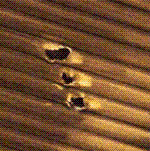Tim Furniss/LONDON

Three liquid hydrogen coolant tubes - not one as had been presumed earlier - in one of the main engines of last month's Space Shuttle STS93 Columbia were punctured by a small plug used to seal a liquid oxygen injector tube which came loose as the main engines started, says NASA.
The ruptured tubes leaked more than 1,500kg (3,300lb) of liquid hydrogen during the ascent, causing it to overheat and use 1,800kg more liquid oxygen than expected, resulting in a slightly premature shutdown of the main engines, 1,100m (3,600ft) short of the planned initial orbit (Flight International, 4-10 August). The leak did not endanger the Shuttle, but a larger leak from 20-40 of the 1,000 coolant tubes would have caused the overheating engine to shut down, possibly forcing the first Return to Launch Site (RTLS) abort in the programme.
An RTLS had been considered by the crew when two primary engine controllers were lost due to a short circuit 5s after launch, triggering warning lights. The back-up computer controllers took over, but the lost redundancy made the ascent more risky.
NASA says the short circuit was due to a wiring defect inside the orbiter's fuselage, with electrical arcing occurring between exposed wire and a metal screw head which had worn through insulation during the previous 25 Columbia flights.
Inspections to the wiring on Columbia and the orbiter Atlantis will be conducted, but not on the orbiter Endeavour, which is already packed with its synthetic aperture radar payload for a lift-off on 16 September. The Endeavour, the youngest orbiter, has flown only 13 missions and engineers are less concerned about potential wear and tear.
Meanwhile, the NASA Chandra X-Ray Observatory has been placed into its operating orbit by the fifth firing of the craft's integral propulsion system. The observatory, deployed in low earth orbit attached to an inertial upper stage from STS93 Columbia on 23 July, is in a 9,676 x 139,141km orbit, a variation of less than 1% from its target orbit.
Chandra is expected to begin its science operations by the end of this month. Over the next five years, Chandra will provide images of phenomena such as quasars, black holes, remnants of exploding stars and clouds of gas that comprise clusters of galaxies.
Source: Flight International























